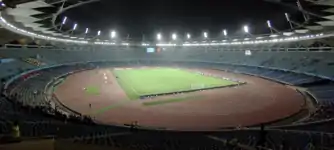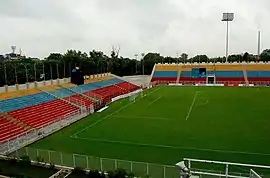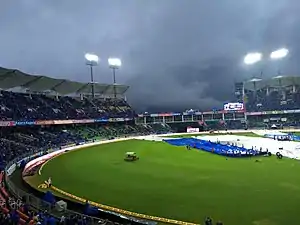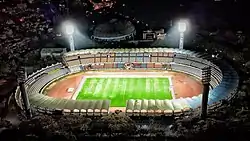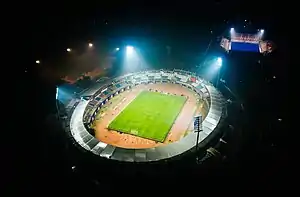Football in India
Association football is one of the three most-popular sports in India, the others being cricket and kabaddi.[5] The Asian Football Confederation (AFC) recognises the Indian Super League as the national football league of India.[6] The Santosh Trophy is a knock-out competition among Indian states and government institutions.
India hosted the 2017 FIFA U-17 World Cup, the first FIFA event the country hosted; it was called the most successful FIFA U-17 World Cup ever, with a record-breaking attendance of 1,347,133, exceeding China's previous record of 1,230,976 in 1985. India also hosted the 2022 FIFA U-17 Women's World Cup and bid to host the 2019 FIFA U-20 World Cup but lost to Poland.[7]
The Indian national football team qualified for the 1950 FIFA World Cup but did not participate.[8]
History
Pre-independence
British soldiers introduced football into India in the mid-nineteenth century.[9][10] Games were initially played between army teams but clubs were soon set up around the country. In 1872, Calcutta FC was the first football club to be established, though the side may have originated as a rugby club that switched codes as late as 1894. Other early clubs include Dalhousie AC, Traders Club and Naval Volunteers Club.[11] Several other football clubs such as Sovabazar, Mohun Bagan and Aryan Club were established in Calcutta in the 1890s. Calcutta was then the capital of British India and soon became the hub of football. Tournaments like the Gladstone Cup, the Trades Cup and the Cooch Behar Cup were started around this time.[12] The Durand Cup and IFA Shield were both started in the late nineteenth century.
The first Indian team to achieve success was Sovabazar Club, which won the Trades Cup in 1892. Mohun Bagan Athletic Club, which was set up in modern-day West Bengal in 1889, became famous in 1911 when it became the first Indian team to win the IFA Shield, a tournament previously won only by British teams based in India. They defeated East Yorkshire Regiment 2–1 in the tournament's final in a victory that is still regarded by many as the greatest win by an Indian team before independence.
_Football_Club_team_1910_-11.jpg.webp)
The Indian Football Association (IFA) was established in Calcutta in 1893 but had no Indians on its board until the 1930s. The All India Football Federation (AIFF), the national governing body of football in India, was formed in 1937 but did not become affiliated with FIFA until at least a decade later. India insisted on playing barefoot whereas other national sides wore boots.[13] Footballer Jyotish Chandra Guha brought global attention to Indian football when he became the first Indian to appear with the English Football League club Arsenal in 1930.[14]
The golden age
India qualified by default for the 1950 FIFA World Cup in Brazil because all of their scheduled opponents withdrew. India did not compete in the tournament. It was not because of a lack of financial assistance, particularly to purchase tickets for the sea journey, or because the team were not allowed to play barefoot.[13][15] According to sports journalist Jaydeep Basu, the financial barrier was solved as state associations provided financial help to the AIFF and that FIFA also promised to provide money.[8]
FIFA had imposed a rule banning barefoot play following the 1948 Olympics where India had played barefoot. According to then-captain Shailen Manna, this story was circulated to justify the AIFF's decision to not participate. Since 1950, the Indian national team has not come close to qualifying for the World Cup.[15][16][17][18] The AIFF had organised training is Calcutta for the 1950 World Cup and the board organised a series of meetings relating to India's participation but was not able to reach a decision. One to two weeks before the World Cup, the AIFF resorted to coming up with excuses to abandon the World Cup trip. This did not face much criticism in 1948 because the FIFA World Cup was not as popular as it is now.[8]
1951–1962 is widely considered the "golden age" of Indian football. In this period, the national team won numerous titles under the coaching of Syed Abdul Rahim. India won the gold medal in the first Asian Games in 1951, beating Iran by one goal. In 1956, no longer playing barefoot, India reached the semi-final in the 1956 Melbourne Olympics, becoming the first Asian country to do so and ranking fourth in the tournament. In 1962, India again won the gold in the Asian Games at Jakarta, defeating South Korea 2–1.[13] [8] India also won the Merdeka Cup and the Quadrangular Tournament, while East Bengal garnered good reviews after touring Romania. Also in 1951, India achieved their highest World Football Elo Rating of 31. According to former FIFA president Sepp Blatter, India is "the sleeping giant of world football".[19]
Decline
Rahim's death in the early 1960s caused the Indian national team to gradually lose their position as a top Asian team. India has not qualified for the Olympics since 1960.[13] India qualified for their first Asian Cup in 1964 but failed to win the title. In an international tournament at the 1970 Asian Games, India won the bronze medal after defeating Japan 1–0. The Indian national team qualified for the 1984 AFC Asian Cup for the first time since 1964 but failed to qualify for the knockout stage after finishing last in their group of five teams.
The Indian youth team jointly won the Youth Asian Cup with Iran in 1974, the first and only title for India at the youth level. In club football, on 24 September 1977, Mohun Bagan held onto a 2–2 draw at the Eden Gardens stadium in Calcutta, against a Pele-led New York Cosmos. Mohun Bagan would have won the tie had it not been for a controversial penalty awarded to the visiting team that ensured the draw. The next day, the newspaper Ananda Bazar Patrika described Goutam Sarkar as "India's very own Beckenbaur".
The Indian women's team as they began playing in the 1970s. In 1975, their first manager was Sushil Bhattacharya.[20][21] The Indian women's team were runners-up in the AFC Women's Asian Cup in 1980 and 1983. In the 1990s, the women's team rapidly declined and a series of defeats followed. In 2009, FIFA delisted the Indian women's team from the world rankings.[22]
2007–present
In August 2007, the Indian national team won the Nehru Cup for the first time, beating Syria 1–0.[23] In August of the following year, India defeated Tajikistan 4–1 to win the AFC Challenge Cup and qualified for the 2011 AFC Asian Cup in Qatar. In August 2009, India again won the Nehru Cup, beating Syria on penalties (6–5).
In January 2011, India played in the 2011 Asian Cup, the country's first Asian Cup for 24 years. India was eliminated in the group stage, which included South Korea, Australia, and Bahrain.
Since the 2011 Asian Cup, the All India Football Federation (AIFF) has been working to improve Indian football. They allowed former coach Bob Houghton to coach the Indian team in the 2012 AFC Challenge Cup qualifiers. After going first in their AFC Challenge Cup group, Houghton was replaced by Wim Koevermans. The India national under-23 football team won the first round of the 2012 Olympics qualifiers against Myanmar but were eliminated by Qatar. India played their next official matches against United Arab Emirates in the 2014 FIFA World Cup qualifiers, which India lost on aggregate 5–2.
In 2014, India hosted the first Unity World Cup in Goa, Hyderabad and Bangalore. India has participated in and hosted the 2017 FIFA U-17 World Cup tournament. This was the first time a team representing India participated in the finals of a FIFA-organised world tournament. India was placed in Group A along with the United States, Ghana and Colombia. On 6 October 2017, India played their first match in the FIFA U-17 World Cup in front of 47,000 people against the United States, losing the match 0–3. India played their second match against Colombia. In the 82nd minute, Jeakson Singh became the first Indian goal scorer in the finals of a FIFA-organised tournament. For the third match of the group stage, India played Ghana, losing the match 4–0 and finishing at the bottom of Group A.[24]
In 2018 Indian youth football teams made history by defeating Argentina U-20 2–1 in the COTIF cup, as well as Iraq U-16, the defending champions of the AFC U-16 Championship (now the AFC U-17 Championship), by 1–0. The U-16 team qualified for the 2018 AFC U-16 Championship, where they came close to qualifying for the 2019 FIFA U-17 World Cup, but lost to South Korea by a single goal in the quarterfinal.[25]
The Indian national team qualified for the 2019 AFC Asian Cup after missing the 2015 edition. India beat Thailand by 4–1, their biggest-ever win at the Asia Cup and their first win in 55 years.[26][27] Nevertheless, they lost both of their next two group matches against UAE and Bahrain by 0−2 and 0−1 respectively[28][29] and finished at the bottom of the group, thus failing to move to the knockout stage.[30]
Administration
Football in India is administered by the All India Football Federation (AIFF), which is affiliated with the Asian Football Confederation (AFC) and the worldwide football governing body FIFA. The India national football team has entered the regional Asian Cup competition but has never competed in a World Cup. The India women's national football team has also played in competitions, and has its own inter-state and state competitions. Youth football is administered by the Sports Authority of India.
National team
| National teams of India | |||
|---|---|---|---|
| Football (Men's) | Football (Women's) | Olympic team | Football U-20 (men's) |
| Football U-17 (men's) | Football U-20 (women's) | Football U-17 (women's) | Futsal (men's) |
| Futsal (women's) | Beach soccer (men's) | Esports | Minifootball / Football 6 / Football 7 |
The India national football team is governed by the All India Football Federation (AIFF) and is a member of the Asian Football Confederation (AFC). Since 1948, the AIFF has been affiliated with FIFA, the international governing body for world football. In 1954, the AIFF became one of the founding members of the AFC.
There are other Indian national teams, such as the under-23 team and the under-17 team. The U-23 team is considered to be a feeder team for the national team.
Performance
The following list includes the performance of all of India's national teams at major competitions.
Men's senior team
The Indian senior national team had several successes during their initial years but is no longer considered one of the best in Asia. The national team's highest achievement is winning two gold medals at the Asian Games.
| Tournament | Appearance in finals | Last appearance |
Best performance |
|---|---|---|---|
| FIFA World Cup | 0 out of 22 | —[lower-alpha 1] | – |
| AFC Asian Cup | 4 out of 17 | 2019 | Runners-up (1964) |
| Summer Olympics (1908–1988) | 4 out of 17 | 1960 | Fourth-place (1956) |
| Asian Games (1951–1998) | 11 out of 13 | 1998 | Champions (1951, 1962) |
| SAFF Championship | 12 out of 12 | 2021 | Champions (1993, 1997, 1999, 2005, 2009, 2011, 2015, 2021) |
| South Asian Games | 7 out of 8 | 1999 | Champions (1985, 1987, 1995) |
- 1950 (qualified but withdrew)
Women's senior team
The women's national team was started in the 1970s; they were twice runners-up in the Women's Asian Cup in the early 1980s. After the AIFF took charge of the team, they began to suffer massive defeats and declined in the late 2000s. In the late 2010s, the AIFF revived the team to empower women's football and the team performed well in a large number of friendlies. The AIFF won the hosting bid for the 2022 AFC Women's Asian Cup.
| Tournament | Appearance in finals | Last appearance |
Best performance |
|---|---|---|---|
| AFC Women's Asian Cup | 9 out of 19 | 2022 | Runners-up (1980, 1983) |
| Asian Games | 2 out of 7 | 2014 | Eighth-place (1998) |
| SAFF Women's Championship | 6 out of 6 | 2022 | Champions (2010, 2012, 2014, 2016, 2019) |
| South Asian Games | 3 out of 3 | 2019 | Champions (2010, 2016, 2019) |
Men's U-23 team
| Tournament | Appearance in finals | Last appearance |
Best performance |
|---|---|---|---|
| Asian Games | 4 out of 5 | 2014 | Tenth-place (2002) |
| South Asian Games | 4 out of 5 | 2016 | Runners-up (2004, 2016) |
Men's U-20 team
Includes them U-19 and U-18 teams' performance.
| Tournament | Appearance in finals | Last appearance |
Best performance |
|---|---|---|---|
| AFC U-20 Asian Cup | 22 out of 40 | 2006 | Champions (1974) |
| SAFF U-18 Championship | 4 out of 4 | 2022 | Champions (2019, 2022) |
Men's U-17 team
Includes the U-16 and U-15 teams' performance.
| Tournament | Finals appearance |
Last appearance |
Best performance |
|---|---|---|---|
| FIFA U-17 World Cup | 1 out of 19 | 2017 | Group stage (2017) |
| AFC U-17 Asian Cup | 8 out of 18 | 2018 | Quarterfinals (2002, 2018) |
| SAFF U-15 Championship | 7 out of 7 | 2022 | Champions (2013, 2017, 2019, 2022) |
Women's U-20 team
Includes the U-19 and U-18 teams' performance.
| Tournament | Finals appearance |
Last appearance |
Best performance |
|---|---|---|---|
| AFC U-20 Women's Asian Cup | 3 out of 10 | 2006 | Quarterfinals (2004) |
| SAFF U-18 Women's Championship | 3 out of 4 | 2023 | Champions (2022) |
Women's U-17 team
Includes the U-16 and U-15 teams' performance.
| Tournament | Finals appearance |
Last appearance |
Best performance |
|---|---|---|---|
| FIFA U-17 Women's World Cup | 1 out of 7 | 2022 | Group stage (2022) |
| AFC U-17 Women's Asian Cup | 1 out of 8 | 2005 | Group stage (2005) |
| SAFF U-15 Women's Championship | 3 out of 4 | 2019 | Champions (2018, 2019) |
Club competitions
As of 2023, India has four national-level leagues. The Indian Super League is the top league, followed by I-League, I-League 2 and I-League 3. I-League 3 currently acts as a final round for the top teams in the state leagues that are nominated by state football associations. India has several cup tournaments, including the Durand Cup, Super Cup and IFA Shield.
Evolution of the tier system
| Leagues | Years | 1888–1993 | 1893–1898 | 1898–1941 | 1941–1977 | 1977–1996 | 1996–1997 | 1997–2001 | 2001–2006 | 2006–2007 | 2007–2011 | 2011–2014 | 2014–2017 | 2017–2022 | 2022–2023 | 2023–present | |
|---|---|---|---|---|---|---|---|---|---|---|---|---|---|---|---|---|---|
| Level | None | 1893 | 1937 | ||||||||||||||
| National leagues | 1 | Formation of Indian Football Association (IFA) | Calcutta Football League | Formation of All India Football Federation (AIFF) | Santosh Trophy | National Football League | I-League | Indian Super League | Indian Super League | ||||||||
| I-League | |||||||||||||||||
| 2 | None | None | NFL Second Division | I-League 2nd Division | I-League | ||||||||||||
| 3 | None | NFL Third Division | Discontinued | I-League 2 | |||||||||||||
| 4 | None | I-League 3 | |||||||||||||||
| Regional leagues | 5–11 | State leagues | |||||||||||||||
| Tournaments/Cups | Durand Cup | Durand Cup | |||||||||||||||
| IFA Shield | IFA Shield | ||||||||||||||||
| Federation Cup | Super Cup | Federation Cup | |||||||||||||||
| Indian Super Cup | Discontinued | ||||||||||||||||
| Santosh Trophy | |||||||||||||||||
Leagues
Tier 1: Indian Super League
The I-League, which was promised to be a professional league, soon lost popularity due to poor marketing.[31] A deal between Zee Sports and the AIFF, which was initially to be a ten-year term in 2006, was terminated in 2010 after a disagreement between the parties. The AIFF then signed a ₹700-crore deal with Reliance Industries and the International Management Group (IMG) on 9 December 2010.[32] The Indian Super League (ISL) was officially launched on 21 October 2013 by IMG–Reliance Industries, Star Sports, and the AIFF to grow the sport of football in India and increase its exposure in the country with big names and professionalism.[33] Large corporations, Bollywood stars and cricketers between them bought eight franchises.[34]
In 2017, the AFC opposed allowing the ISL to become the main league in India, but the I-League clubs East Bengal and Mohun Bagan wanted a complete merger of the ISL and I-League.[35] Two weeks later, the AIFF proposed the Indian Super League and I-League would simultaneously run on a short–term basis, with the I-League winner qualifying for the AFC Champions League and the ISL champion reaching the AFC Cup qualification stage.[36] The AFC approved this proposal on 25 July 2017, with the ISL replacing the domestic cup competition, the Federation Cup, which was a true knockout cup competition.[37]
Two seasons later, the AIFF and AFC met again to determine the future for Indian football. After the meeting, it was announced the Indian Super League would become the top-tier league with the AFC Champions League slot while the I-League was now the domestic cup tournament with the AFC Cup slot. The AFC also made some key recommendations: the first was to open a pathway for two I-League clubs to enter into the ISL by the end of the 2020–2021 season, subject to certain criteria being fulfilled. The second recommendation was to allow the winner of the I-League a chance of promotion to the ISL with no participation fee, with the AIFF defining the basic fulfilling sporting merit and the national club-licensing criteria starting in the 2022–2023 season. The final recommendation was to introduce promotion and relegation into the top league by the end of the 2024–2025 season, and to abolish the existence of two parallel leagues.[38]
Tier 2: I-League
Starting in the 2022–2023 season, I-League lost its top-tier status. The champions of the 2022–23 I-League were promoted to the ISL with no participation fee. As per the AFC's recommendation for 2024–2025, it was agreed the AIFF would fully implement promotion and relegation between the two leagues.[39]
Tier 3: I-League 2
After demoting I-League to the second tier status in Indian football, I-League 2 was subsequently demoted to the third tier. AIFF renamed the 2nd Division to I-League 2 to avoid disambiguation.[40]
Tier 4: I-League 3
I-League 3 is set to serve as a platform for state champions and state-nominated teams. No ISL reserve teams can be a part of I-League 2 or I-League 3.
Tier 5–11: Indian State leagues
There are currently a total of 37 state associations (including union territories) affiliated with the AIFF.[41] These state associations are affiliated with state leagues. The top teams of state leagues are eligible to apply for I-League 3. Some state leagues have multiple divisions and a promotion/relegation system between these divisions. Calcutta Football League in West Bengal is the oldest state league and has the highest number of divisions (seven divisions) with a promotion/relegation system in place.[42]
Cups
| Competition | Organizer | Host city/state | Note |
|---|---|---|---|
| Federation Cup | AIFF | Various | |
| Durand Cup | DFTS (Durand Football Tournament Society) & AIFF | Various | |
| Super Cup | AIFF | Various | |
| Indian Super Cup | AIFF | Various | |
| IFA Shield | IFA | Kolkata | |
| Rovers Cup | WIFA | Mumbai | |
| Stafford Challenge Cup | KSFA | Bengaluru |
Federation Cup
The Federation Cup (Fed Cup) is an annual, knockout-style, club football tournament in India that started in 1977. Until I-League's inception in 1997 (then called the NFL), it was the most-prestigious, national-level, club football tournament in India. Previously, the winning club of the Fed Cup had a chance to compete at the continental level in the AFC Cup along with the I-League champion team. The Fed Cup has been discontinued since the 2017–2018 season when a new Super Cup was inaugurated.
Durand Cup
In 1888, the Durand Football Tournament, commonly known as the Durand Cup, was started by India's foreign secretary Mortimer Durand at Simla. The Durand Cup's initial matches were played in Dagshai and was created as a form of recreation for British troops stationed in India. The Durand Cup was suspended during World War I and World War II. In 1940, the tournament's venue was shifted to New Delhi.
Super Cup
The Super Cup is a knockout football tournament. The top six teams from the two top-tier leagues, the I-League and the Indian Super League qualify directly for the main round of the competition. The bottom four clubs from each league participate in a qualification round to compete.
IFA Shield
The IFA Shield is an annual football competition organized by the Indian Football Association (IFA) in West Bengal. It was started in 1893, and is the fourth-oldest club cup competition in the world after the FA Cup, the Scottish Cup and the Durand Cup. Along with local clubs in Bengal, clubs from other parts of India and from overseas are able to participate in this tournament.
Senior National Football Championship / Santosh Trophy
The Santosh Trophy, also known as the Senior National Football Championship, is an annual Indian football tournament contested by states and government institutions. The trophy is named after the late Maharaja Sir Manmatha Nath Roy Chowdhary of Santosh. The first winners were Bengal, who also lead the all-time winners list with 32 titles to date.
Champions overview
The competitions currently active in Indian football.
| Club competition | ||
|---|---|---|
| Tournament | Current champions | Reference |
| Indian Super League |
|
|
| I-League | RoundGlass Punjab | |
| Super Cup | Odisha | |
| Durand Cup | Bengaluru | |
| I-League 2 | Delhi | |
| Indian Women's League | Gokulam Kerala Women | |
| Elite Youth League | Classic FA | |
| Futsal Club Championship | Minerva Academy | |
| State competition | ||
|---|---|---|
| Tournament | Current champions | Reference |
| Santosh Trophy | Karnataka | |
| National Games (Men) | West Bengal | |
| Junior NFC (U19) | Mizoram | |
| Sub-Junior NFC (U16) | Meghalaya | |
| Senior Women's NFC | Tamil Nadu | |
| National Games (Women) | Manipur | |
| Junior Girl's NFC (U19) | Dadra and Nagar Haveli | |
| Sub-Junior Girl's NFC (U17) | Jharkhand | |
| National Beach Soccer Championship | Kerala | |
Qualification for Asian competitions
| Competition | Qualifying team | Notes |
|---|---|---|
| AFC Champions League | Premiers of Indian Super League | Qualification to the Group stage |
| AFC Cup | Winners of Super Cup | Qualification to the Group stage |
| Champions or league stage runners-up of Indian Super League | Qualification to the Qualifying play-off | |
| AFC Women's Club Championship | Champions of Indian Women's League | Qualification to the Group stage |
Women's football
Women's football in India was administered by the Women's Football Federation of India (WFFI) from 1975 until the early 1990s when the WFFI was absorbed into the AIFF. There are complaints women's football is treated as inferior to the men's game, leading to unfulfilled plans to de-merge the WFFI.[43]
In India, women's football began in West Bengal. The large Kolkata teams East Bengal and Mohun Bagan started women's club sides in the 2000–2001 season, and they participate with other teams in the Calcutta Women's Football League. Players from Odisha and Manipur have made advances in the game and make up a large part of the India women's national football team.
The women's national competition is played on a state-against-state basis in the India women's football championship.[44] There are similar national championships for junior teams like the Junior Girls National Championship for under 19s and the Under-17 Girls National Championship.
Some Indian female players have become internationally recognised. Among them are Chitra Gangadharan who was selected to play for the All Asian Star team. Jaanki Kotecha was selected as captain to the All Asian Star Team in 2008–2009 and led her team to victory. In February 2000, Sujata Kar and Alpana Sil became the first Indian footballers to sign a contract outside India. They signed with the German team TSV Crailsheim but had to return to India after a month due to problems with the clearance of their international transfer.[45]
Until 1983, women footballers took part in international tournaments like the AFC Women's Asian Cup. The Indian team won silver in 1980 at Calicut. In later years, the status of the Indian women's team declined. During the 2003 AFC Women's Championship, the Indian team was defeated 12–0 by China.[46]
The AIFF's poor support of the national women's team became evident when a trip to Germany was only made possible by Non Resident Indians in that country and by the support of the German Football Association. Championships are held in remote locations, and national media coverage is said to be restricted to state and local newspapers.[43]
In June 2009, FIFA delisted the Indian women's side from its world rankings for being inactive for more than 18 months. At that time, the game was gaining in popularity with young Indian females, as evident by the local leagues in the country. The Mumbai Women's Football League of 2009–2010 was organised by the Mumbai District Football Association (MDFA) was a major success and included many players who had played for the national team. The popularity of the event gave hope of a resurgence of the women's game in India.[47]
Indian Women's League
On 21 April 2016, over a year after the AIFF started plans for a women's football league, AIFF president Praful Patel said a women's football league would begin in October 2016 with six teams, and was planned to be expanded to eight teams by 2017.[48] On 5 July 2016, the AIFF organized a workshop to discuss the India women's national team and the proposed women's football league. Indian Super League sides Delhi Dynamos, Chennaiyin FC, Kerala Blasters, FC Pune City and Atletico de Kolkata, and I-League teams Bengaluru FC, Aizawl FC and Mumbai FC attended the workshop. It was announced the league would consist of the eight teams in the league and two other teams would be chosen through a pre-qualification round.[49]
On 14 October, the AIFF announced the preliminary rounds for the Women's League would begin on 17 October 2016; ten teams are split into two groups of five teams and the winner from each group qualifies for the national finals.[50]
Stadiums
As of 2023, few of India's national football stadiums meet current world standards. The largest stadiums in India are Salt Lake Stadium in Kolkata with a seating capacity of 85,000; Jawaharlal Nehru Stadium in New Delhi with a capacity of over 60,000; and Ambedkar Stadium with a capacity of 35,000. Barabati Stadium in Cuttack and Kalinga Stadium in Bhubaneswar are major arenas for football events in Odisha. In Sikkim, the 30,000-capacity Paljor Stadium in Gangtok is famous as one of the most beautiful stadiums in the world because of its backdrop of the Himalayas. The main stadium in Shillong is Jawaharlal Nehru Stadium (JLM) with a capacity of 30,000 standing. Both the Paljor and the JLN in Shillong have been renovated with artificial playing surfaces. Some other important stadiums are Shree Shiv Chhatrapati Sports Complex in Pune, Barasat Stadium in Barasat, the Fatorda in Goa, Kaloor International Stadium in Kochi, Municipal Corporation Stadium in Kozhikode, Jawaharlal Nehru Stadium in Guwahati and the EKA Arena in Ahmedabad. There are hundreds of other stadiums in the country. The following stadiums are affiliated by All India Football Federation.
International competitions hosted
Nehru Cup
The Nehru Cup was an international invitational association football tournament organised by the AIFF and named after the First Prime Minister of India Jawaharlal Nehru.
| Editions | Winners |
|---|---|
| 1982 | |
| 1983 | |
| 1984 | |
| 1985 | |
| 1986 | |
| 1987 | |
| 1988 | |
| 1989 | |
| 1991 | |
| 1993 | |
| 1995 | |
| 1997 | |
| 2007 | |
| 2009 | |
| 2012 |
Tri-Nation Series
The Tri-Nation Series is a three-team football tournament organised by the AIFF. The first edition was held in 2017.
| Editions | Winners |
|---|---|
| 2017 | |
| 2023 |
Intercontinental Cup
The Intercontinental Cup is a four-team association football tournament organised by the AIFF. The first edition was held in 2018.
| Editions | Winners |
|---|---|
| 2018 | |
| 2019 | |
| 2023 |
Media
The Indian Super League is officially broadcast on Star Sports network in India. International coverage is done by OneFootball.
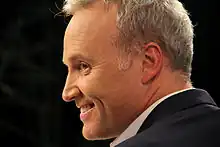
Seasons
The following articles detail the major results and events in each season of Indian football since 2011.
| 2010s: | 2011–12 | 2012–13 | 2013–14 | 2014–15 | 2015–16 | 2016–17 | 2017–18 | 2018–19 | 2019–20 |
| 2020s: | 2020–21 | 2021–22 | 2022–23 | 2023–24 |
See also
- AIFF Player of the Year Awards
- Elite League
- Football in Asia
- Futsal Association of India
- Junior National Football Championship
- Football in Kolkata
- List of football clubs in India
- List of Indian players in foreign leagues
- Mission XI Million
- South Indian derby
- Sport in India
- History of the India national football team
- SAFF Club Championship
In popular culture
- Goal (2007)
- Maidaan (2023), upcoming Hindi movie of Ajay Devgn about Indian football's golden era of the 1950s.
- List of movies made on 'Football sport' in India
- List of Indian sport movies
References
- Sharma, Mukesh (11 July 2010). "BBC Sport — Football — World Cup 2010: India's football absence examined". BBC News. Archived from the original on 13 January 2014. Retrieved 15 February 2014.
- Wilson, Bill (10 April 2012). "BBC News — Football looks to score in India". Bbc.co.uk. Archived from the original on 20 February 2014. Retrieved 15 February 2014.
- "India skipped FIFA World Cup in 1950". Archived from the original on 6 August 2021. Retrieved 2 June 2022.
- "Mohun Bagan and East Bengal: A derby to remember". inbedwithmaradona.com. Archived from the original on 4 February 2017. Retrieved 5 December 2015.
- Sharma, Nandini. "Sports Galore: Uncovering India's Top 20 Most Popular Sports". Kreedon. Archived from the original on 31 May 2023. Retrieved 26 July 2023.
- "BBC News — Can India ever learn to love football?". BBC News. Bbc.co.uk. 14 February 2014. Archived from the original on 16 February 2014. Retrieved 15 February 2014.
- "FIFA Council decides on key steps for the future of international competitions". FIFA.com. Fédération Internationale de Football Association. 16 March 2018. Archived from the original on 17 March 2018.
- https://www.economictimes.com/news/sports/did-india-miss-1950-world-cup-for-playing-barefoot-new-book-debunks-theory/amp_articleshow/94540704.cms.
{{cite web}}: Missing or empty|title=(help) - Pillai, Manu S (8 June 2018). "How football kicked off in India | As with the English language, when the British transported the sport to India, they didn't expect the 'natives' to beat them at it". lifestyle.livemint.com. Delhi, India: Livemint Delhi. Archived from the original on 14 July 2022. Retrieved 27 January 2022.
- Guha, Chandak (5 September 2019). "ইংরেজরাও ভয় পেত বাংলার প্রথম কিংবদন্তি ফুটবল কোচকে" [The Englishmen too feared Bengal's legendary first football coach]. bongodorshon.com (in Bengali). Kolkata: Bongodorshon Information Desk. Archived from the original on 8 September 2023. Retrieved 24 October 2022.
- "History of Football in India". TheSportsCampus.com. 19 May 2008. Archived from the original on 25 August 2012. Retrieved 15 February 2014.
- Kumar Shil, Amrita (15 May 2022). "Football Culture in Princely State of Cooch Behar" (PDF). JHSR Journal of Historical Study and Search. 2. ISSN 2583-0198. Archived from the original (PDF) on 16 April 2023. Retrieved 16 April 2023.
- "Soutik Biswas's India: Why is India not at the World Cup?". BBC. 18 June 2010. Archived from the original on 24 November 2013. Retrieved 15 February 2014.
- "EAST BENGAL CLUB, INDIA – RECORDS, FUNS AND FACTS: 1930 – EAST BENGAL CLUB AND ARSENAL FC CONNECTION". eastbengalclubrecords.wordpress.com. 31 March 2016. Archived from the original on 26 February 2021. Retrieved 12 September 2021.
- "Fit to Post: Yahoo! India News " Blog Archive Barefoot in Bengal and Other Stories "". Archived from the original on 14 June 2010. Retrieved 15 February 2014.
- Lisi (2007), p. 49
- "1950 FIFA World Cup Brazil – Overview". FIFA. Archived from the original on 18 March 2012. Retrieved 15 February 2014.
- Arunava Chaudhuri. "The Indian National Team's World Cup qualifying". Archived from the original on 20 March 2013. Retrieved 15 February 2014.
- "As India is gripping onto the football fever, take a look at the best football stadiums in India! - Nativeplanet". nativeplanet.com. Archived from the original on 14 May 2018. Retrieved 14 May 2018.
- Arunava Chaudhuri (21 July 2015). "India's first women's football national team coach Sushil Bhattacharya passed away". Sportskeeda. Archived from the original on 24 September 2015. Retrieved 21 July 2015.
- Doyle, Jennifer (28 January 2010). "A World Cup Dream Revives India's Women's Soccer Team". NY Times. India. Archived from the original on 21 February 2017. Retrieved 7 November 2012.
- Doyle, Jennifer (29 January 2010). "A World Cup Dream Revives India's Women's Team". The New York Times. Archived from the original on 8 August 2018. Retrieved 19 September 2012.
- "India upstage Syria 1–0 to lift Nehru Cup". Reuters. 29 August 2007. Archived from the original on 6 September 2009. Retrieved 6 December 2007.
- "Official Emblem launched for FIFA U-17 World Cup India 2017". Fédération Internationale de Football Association. 27 September 2016. Archived from the original on 1 October 2016. Retrieved 9 October 2016.
- "Argentina & Iraq slayed in an incredible day for India football! | Goal.com". Archived from the original on 7 August 2018. Retrieved 7 August 2018.
- "Group A: Thailand 1-4 India". The AFC.com. 6 January 2019. Archived from the original on 6 January 2019. Retrieved 6 January 2019.
- "AFC Asian Cup 2019: Thailand 1-4 India, Player Ratings". FOX Sports Asia. 6 January 2019. Archived from the original on 7 January 2019. Retrieved 6 January 2019.
- "UAE Steal India'S Thunder". the-aiff.com. AIFF. 10 January 2019. Archived from the original on 3 July 2021. Retrieved 14 January 2019.
- "AFC Asian Cup UAE 2019, India vs Bahrain". the-afc.com. AFC. Archived from the original on 18 January 2019. Retrieved 14 January 2019.
- Ishfaq Ahmed, Shiddant Aney, Vaibhav Raghunandan (14 January 2019). "India Lose to Bahrain, Crash Out of AFC Asian Cup - Highlights and Analysis". newsclick.in. Archived from the original on 15 January 2019. Retrieved 14 January 2019.
{{cite web}}: CS1 maint: multiple names: authors list (link) - Dhar, Pulasta (6 January 2016). "The fall of the I-league". Livemint. Archived from the original on 16 August 2017. Retrieved 13 August 2017.
- "AIFF signs 700-crore deal with IMG-RIL". Times of India. 9 December 2010. Archived from the original on 30 May 2014. Retrieved 14 July 2014.
- "Reliance, Star India, IMG Set to Launch ISL". Indian Super League. 21 October 2013. Archived from the original on 13 March 2016. Retrieved 12 August 2017.
{{cite news}}: CS1 maint: bot: original URL status unknown (link) - "Sachin Tendulkar, Sourav Ganguly foray into football, win ISL bids". Times of India. 13 April 2014. Archived from the original on 2 November 2014. Retrieved 3 August 2014.
- "Still no consensus on ISL, I-League merger despite high-profile meet". The Times of India. 7 June 2017. Archived from the original on 3 July 2021. Retrieved 13 August 2017.
- "ISL gets official recognition from AFC, becomes second national football league". FirstPost. 28 June 2017. Archived from the original on 2 January 2018. Retrieved 13 August 2017.
- "AFC competitions committee's decisions published". The Asian Football Confederation. 25 July 2017. Archived from the original on 16 August 2017. Retrieved 13 August 2017.
- "India clubs agree to work together on league roadmap". 14 October 2019. Archived from the original on 26 May 2020. Retrieved 23 June 2021.
- "New roadmap for Indian football proposes Hero ISL as premier league". Indian Super League. Archived from the original on 1 January 2022. Retrieved 22 April 2022.
- "AIFF League Committee meeting chaired online by Lalnghinglova Hmar". www.the-aiff.com. Archived from the original on 16 December 2022. Retrieved 17 December 2022.
- "State Associations". All India Football Federation. Archived from the original on 24 October 2017. Retrieved 23 June 2021.
- "Calcutta Football League". Times of India. Archived from the original on 27 June 2021. Retrieved 23 June 2021.
- Autor. "Gender and sport in India: aspects of women's football by Arunava Chaudhuri (english)". Indien-netzwerk.de. Archived from the original on 29 August 2003. Retrieved 5 May 2010.
- "The Official Website Of All India Football Federation". 4 February 2005. Archived from the original on 4 February 2005. Retrieved 15 February 2014.
- Kulkarni, Abhijeet (27 April 2020). "An Indian footballer in Europe: Before Bala Devi, there was Sujata Kar and a huge lost opportunity". scroll.in. Scroll. Archived from the original on 2 May 2021. Retrieved 23 August 2022.
- "Sound planning needed". Sportstaronnet.com. Archived from the original on 20 September 2009. Retrieved 5 May 2010.
- "Women's Home". Football Mumbai. 27 June 2009. Archived from the original on 14 October 2010. Retrieved 5 May 2010.
- "Women's football league from October – Times of India". Timesofindia.indiatimes.com. 21 April 2016. Archived from the original on 26 September 2016. Retrieved 5 April 2017.
- "AIFF conducts workshop for National Women's League – Times of India". Timesofindia.indiatimes.com. 5 July 2016. Archived from the original on 9 July 2016. Retrieved 5 April 2017.
- "Welcome to All India Football Federation". The-aiff.com. 14 October 2016. Archived from the original on 19 October 2016. Retrieved 5 April 2017.
- "FIFA U-17 World Cup: Salt Lake Stadium capacity reduced to 66,687". 10 September 2017. Archived from the original on 11 January 2019. Retrieved 28 February 2023.
- "Eden Gardens, Kolkata, India | Eden Gardens Cricket Grounds, Match Schedule". Archived from the original on 27 March 2020. Retrieved 28 February 2023.
- "K. D. Singh 'Babu' Stadium, Lucknow - Records & stats of Central Sports Stadium, UP, India". Archived from the original on 23 January 2013. Retrieved 24 January 2013.
- "Jawaharlal Nehru Stadium-Kaloor-jaipurKochi". Kerala Cricket Association. Archived from the original on 1 May 2020. Retrieved 28 May 2020.
- "Nehru Stadium". Cricinfo. Archived from the original on 6 August 2020. Retrieved 17 November 2017.
- "We will telecast all group stages matches of FC Goa in the AFC Champions League". Twitter. Star Sports. Archived from the original on 12 August 2022. Retrieved 2 April 2021.
- "Latest Business and Financial News : The Economic Times on mobile". m.economictimes.com. Retrieved 13 June 2023.
Further reading
- "Regionalism and club domination: Growth of rival centres of footballing excellence". Soccer & Society. Taylor & Francis. 6:2–3 (2–3): 227–256. 6 August 2006. doi:10.1080/14660970500106410. Archived from the original on 1 March 2023. Retrieved 1 March 2023.
- "Chronology of Important Sports Events — West Bengal". wbsportsandyouth.gov.in. Kolkata: Government of West Bengal – Department of youth services and sports. 2017. Archived from the original on 13 October 2022. Retrieved 25 January 2023.


